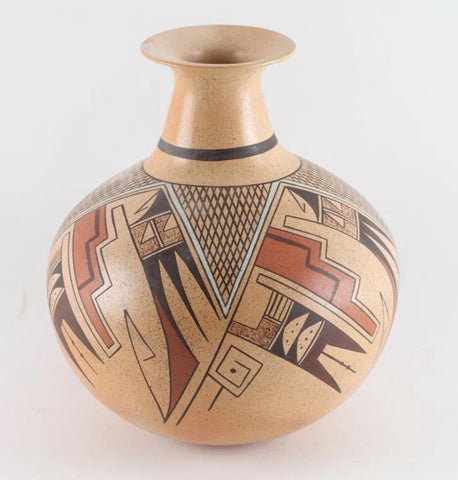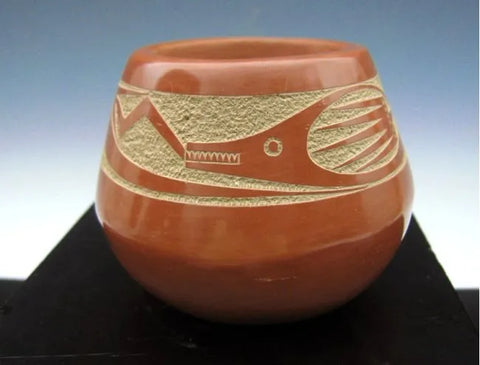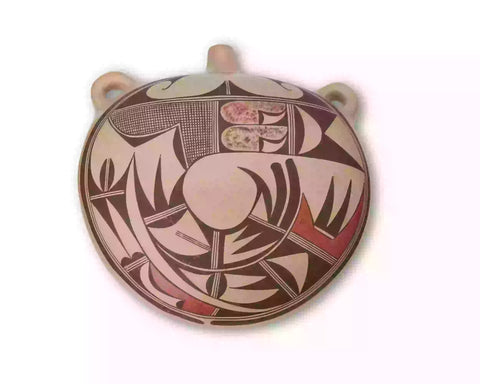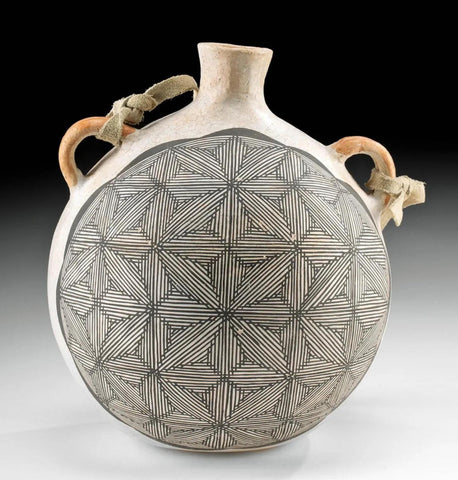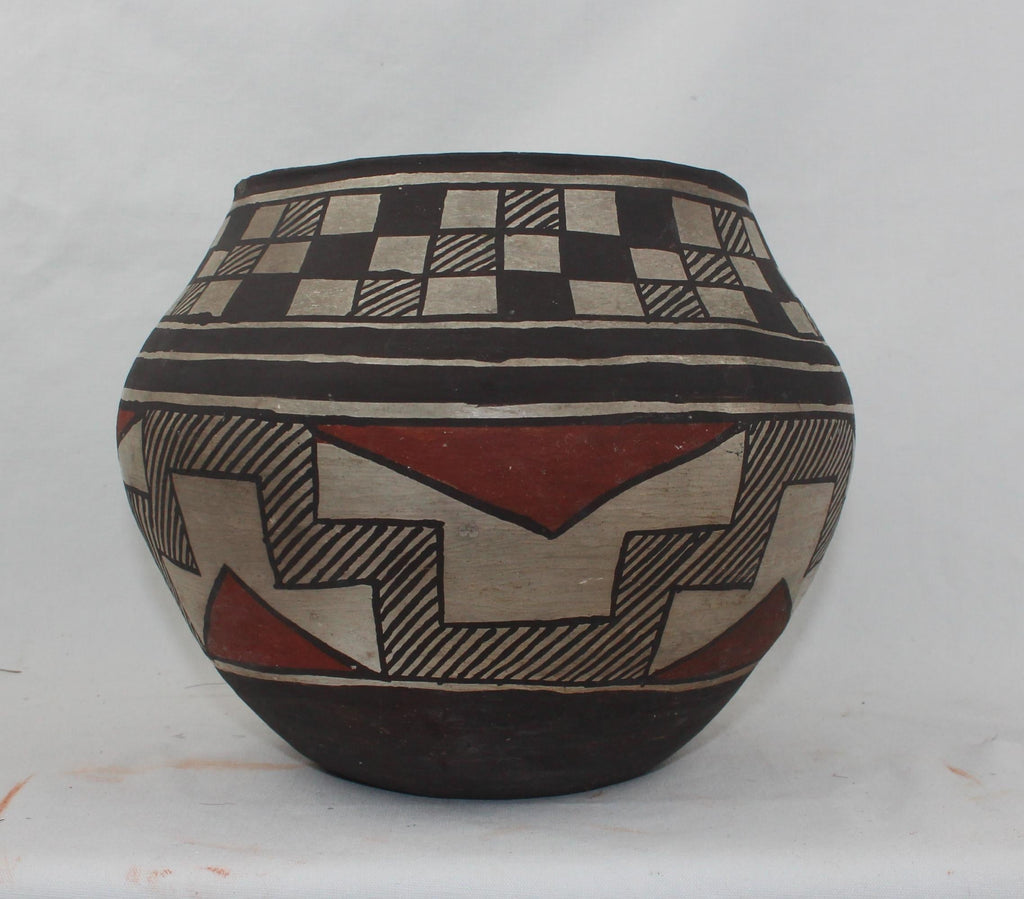
Native America, Historic Laguna Polychrome Pottery Jar, Ca 1890-1920's, #1574 SOLD
$ 3,500.00
Native America, Historic Laguna Polychrome Pottery Jar, Ca 1890-1920's, #1574
Description: #1574 Native America, Historic Laguna Polychrome Pottery Jar, Ca 1890-1920's. Laguna Polychrome Pottery Jar, with a strong Zuni design influence, with stepped hatched design below the shoulder and checkered design at the neck.
Dimensions: 6.5" H x 8" W.
Condition: Exceptional for age
Provenance: From the Bertram and Ruth Malenka Collection, Belmont, Massachusetts.
From the Estate of Bertram and Ruth Malenka, ardent collectors whose passion for works of art and decorative objects spanned continents and centuries. During their more than 60-year marriage, the couple amassed a collection of more than 150 works that they carefully studied, restored, displayed, and admired.
The Malenka's diverse acquirement process grew as their interests evolved. The collection commenced with Japanese ukiyo-e prints that Mr Malenka acquired while stationed in Tokyo, shortly after the Japanese surrendered in WWII. From there, Mr and Mrs Malenka grew their collection to encompass an impressive array of African Art acquired at auction; American Southwest decorative pieces, some of which were purchased from the Santa Fe Indian Market; and then to drawings by modern masters, including Joan Miró and Ernst Ludwig Kirchner, from galleries and auctions. Several of their German Expressionist and Modernist works on paper were featured in the Bonhams, May 14th Impressionist & Modern Art sale held in New York.
MALENKA, Bertram Julian Of Belmont was born June 8, 1923 in Brooklyn, NY, the son of Morris and Mollie and sister, Millicent, who died at an early age. He attended James Madison High School and started college at Columbia with the ambition of becoming an artist. World War II interrupted his education but he returned to Columbia where he captained the fencing team and switched majors to physics. While there he met Ruth Stolper who would go on to become his wife of over 60 years before her death in 2015. Bert went to graduate school at Harvard where he received his PhD in physics and met many of the people who would become his lifelong friends. He stayed at Harvard for several years before moving on to Washington University, Tufts and then Northeastern where he spent the majority of his professional career. Bert's passions were tennis and art. He had a standing game into his early 80's. He believed strongly in the value of museums and their collections and sat on many visiting committees for the Museum of Fine Arts in Boston. His keen intellect and fine eye won him the admiration and friendship of a generation of collectors, curators and dealers. His passions for art and tennis are a legacy shared by his sons and grandchildren. He is survived by his eldest son, David J. (wife Ann, daughter Emma, son Jacob) and his younger son Robert C. (son Nicholas, son Benjamin). Interment at the Mount Auburn Cemetery in Cambridge, MA will be at a later date at the convenience of the family. Swdfuneralhome.com. Arrangements by: Short, Williamson & Diamond Belmont 617.484.6900. Published in The Boston Globe on Oct. 30, 2018
Malenka, Ruth S. (Stolper) Of Belmont, August 6. Beloved wife of Bertram J. Malenka. Dear and devoted mother of David J. Malenka and his wife, Ann M. of Etna, NH and Robert C. Malenka of Palo Alto, CA. Loving grandmother of Jacob C., Emma C., Benjamin J., and Nicholas S. Malenka. Sister of the late Enoch L. Stolper and Virginia Frank. Ruth graduated from high school in Brooklyn at the age of 16 and went on to get her BA at Brooklyn College graduating in 1946. She then completed a Masters at Teacher's College Columbia. In 1948, she began her 67 year marriage to Bertram J. Malenka and moved to Boston to join him as he pursued his doctorate in physics, while she obtained a MSW at Boston University. She spent more than 60 years in social services passionately helping those in need beginning as a case worker at the Margaret Fuller House in Cambridge, the Cambridge Jewish Community Center and the Boston Association for Retarded Children. She moved on to administrative roles running Catalyst in Social Work, as director of Cambridge/Somerville Social Services and then director of Brookline/Newton/Wellesley Social Services. During the Dukakis administration she was Assistant Secretary for Social Services for the Commonwealth of Massachusetts. In her late '70's and '80's, she returned to case work as a social work for VNAs affiliated with Mt. Auburn hospital. She had many other interests including politics, both local in Belmont and on the national level with the Democratic Party. She was a fierce defender of human rights and gave freely of her time and money to support social justice. Together with her husband Bert, she assembled an important collection of art and was a strong supporter of the Boston Museum of Fine Arts. She cared passionately for her family and friends and this "force of nature" will be missed by all who knew her. A memorial service will be scheduled at a later date. www.swdfuneralhome.com. Arrangements by the: Short, Williamson & Diamond Funeral Home Belmont 617-484-6900. Published in The Boston Globe on Aug. 9, 2015
“Pueblo pottery is made using a coiled technique that came into northern Arizona and New Mexico from the south, some 1500 years ago. In the four-corners region of the US, nineteen pueblos and villages have historically produced pottery. Although each of these pueblos use similar traditional methods of coiling, shaping, finishing and firing, the pottery from each is distinctive. Various clay's gathered from each pueblo’s local sources produce pottery colors that range from buff to earthy yellows, oranges, and reds, as well as black. Fired pots are sometimes left plain and other times decorated—most frequently with paint and occasionally with applique. Painted designs vary from pueblo to pueblo, yet share an ancient iconography based on abstract representations of clouds, rain, feathers, birds, plants, animals and other natural world features.
Tempering materials and paints, also from natural sources, contribute further to the distinctiveness of each pueblo’s pottery. Some paints are derived from plants, others from minerals. Before firing, potters in some pueblos apply a light colored slip to their pottery, which creates a bright background for painted designs or simply a lighter color plain ware vessel. Designs are painted on before firing, traditionally with a brush fashioned from yucca fiber.
Different combinations of paint color, clay color, and slips are characteristic of different pueblos. Among them are black on cream, black on buff, black on red, dark brown and dark red on white (as found in Zuni pottery), matte red on red, and polychrome—a number of natural colors on one vessel (most typically associated with Hopi). Pueblo potters also produce undecorated polished black ware, black on black ware, and carved red and carved black wares.
Making pueblo pottery is a time-consuming effort that includes gathering and preparing the clay, building and shaping the coiled pot, gathering plants to make the colored dyes, constructing yucca brushes, and, often, making a clay slip. While some Pueblo artists fire in kilns, most still fire in the traditional way in an outside fire pit, covering their vessels with large potsherds and dried sheep dung. Pottery is left to bake for many hours, producing a high-fired result.
Today, Pueblo potters continue to honor this centuries-old tradition of hand-coiled pottery production, yet value the need for contemporary artistic expression as well. They continue to improve their style, methods and designs, often combining traditional and contemporary techniques to create striking new works of art.” (Source: Museum of Northern Arizona)
Description: #1574 Native America, Historic Laguna Polychrome Pottery Jar, Ca 1890-1920's. Laguna Polychrome Pottery Jar, with a strong Zuni design influence, with stepped hatched design below the shoulder and checkered design at the neck.
Dimensions: 6.5" H x 8" W.
Condition: Exceptional for age
Provenance: From the Bertram and Ruth Malenka Collection, Belmont, Massachusetts.
From the Estate of Bertram and Ruth Malenka, ardent collectors whose passion for works of art and decorative objects spanned continents and centuries. During their more than 60-year marriage, the couple amassed a collection of more than 150 works that they carefully studied, restored, displayed, and admired.
The Malenka's diverse acquirement process grew as their interests evolved. The collection commenced with Japanese ukiyo-e prints that Mr Malenka acquired while stationed in Tokyo, shortly after the Japanese surrendered in WWII. From there, Mr and Mrs Malenka grew their collection to encompass an impressive array of African Art acquired at auction; American Southwest decorative pieces, some of which were purchased from the Santa Fe Indian Market; and then to drawings by modern masters, including Joan Miró and Ernst Ludwig Kirchner, from galleries and auctions. Several of their German Expressionist and Modernist works on paper were featured in the Bonhams, May 14th Impressionist & Modern Art sale held in New York.
MALENKA, Bertram Julian Of Belmont was born June 8, 1923 in Brooklyn, NY, the son of Morris and Mollie and sister, Millicent, who died at an early age. He attended James Madison High School and started college at Columbia with the ambition of becoming an artist. World War II interrupted his education but he returned to Columbia where he captained the fencing team and switched majors to physics. While there he met Ruth Stolper who would go on to become his wife of over 60 years before her death in 2015. Bert went to graduate school at Harvard where he received his PhD in physics and met many of the people who would become his lifelong friends. He stayed at Harvard for several years before moving on to Washington University, Tufts and then Northeastern where he spent the majority of his professional career. Bert's passions were tennis and art. He had a standing game into his early 80's. He believed strongly in the value of museums and their collections and sat on many visiting committees for the Museum of Fine Arts in Boston. His keen intellect and fine eye won him the admiration and friendship of a generation of collectors, curators and dealers. His passions for art and tennis are a legacy shared by his sons and grandchildren. He is survived by his eldest son, David J. (wife Ann, daughter Emma, son Jacob) and his younger son Robert C. (son Nicholas, son Benjamin). Interment at the Mount Auburn Cemetery in Cambridge, MA will be at a later date at the convenience of the family. Swdfuneralhome.com. Arrangements by: Short, Williamson & Diamond Belmont 617.484.6900. Published in The Boston Globe on Oct. 30, 2018
Malenka, Ruth S. (Stolper) Of Belmont, August 6. Beloved wife of Bertram J. Malenka. Dear and devoted mother of David J. Malenka and his wife, Ann M. of Etna, NH and Robert C. Malenka of Palo Alto, CA. Loving grandmother of Jacob C., Emma C., Benjamin J., and Nicholas S. Malenka. Sister of the late Enoch L. Stolper and Virginia Frank. Ruth graduated from high school in Brooklyn at the age of 16 and went on to get her BA at Brooklyn College graduating in 1946. She then completed a Masters at Teacher's College Columbia. In 1948, she began her 67 year marriage to Bertram J. Malenka and moved to Boston to join him as he pursued his doctorate in physics, while she obtained a MSW at Boston University. She spent more than 60 years in social services passionately helping those in need beginning as a case worker at the Margaret Fuller House in Cambridge, the Cambridge Jewish Community Center and the Boston Association for Retarded Children. She moved on to administrative roles running Catalyst in Social Work, as director of Cambridge/Somerville Social Services and then director of Brookline/Newton/Wellesley Social Services. During the Dukakis administration she was Assistant Secretary for Social Services for the Commonwealth of Massachusetts. In her late '70's and '80's, she returned to case work as a social work for VNAs affiliated with Mt. Auburn hospital. She had many other interests including politics, both local in Belmont and on the national level with the Democratic Party. She was a fierce defender of human rights and gave freely of her time and money to support social justice. Together with her husband Bert, she assembled an important collection of art and was a strong supporter of the Boston Museum of Fine Arts. She cared passionately for her family and friends and this "force of nature" will be missed by all who knew her. A memorial service will be scheduled at a later date. www.swdfuneralhome.com. Arrangements by the: Short, Williamson & Diamond Funeral Home Belmont 617-484-6900. Published in The Boston Globe on Aug. 9, 2015
“Pueblo pottery is made using a coiled technique that came into northern Arizona and New Mexico from the south, some 1500 years ago. In the four-corners region of the US, nineteen pueblos and villages have historically produced pottery. Although each of these pueblos use similar traditional methods of coiling, shaping, finishing and firing, the pottery from each is distinctive. Various clay's gathered from each pueblo’s local sources produce pottery colors that range from buff to earthy yellows, oranges, and reds, as well as black. Fired pots are sometimes left plain and other times decorated—most frequently with paint and occasionally with applique. Painted designs vary from pueblo to pueblo, yet share an ancient iconography based on abstract representations of clouds, rain, feathers, birds, plants, animals and other natural world features.
Tempering materials and paints, also from natural sources, contribute further to the distinctiveness of each pueblo’s pottery. Some paints are derived from plants, others from minerals. Before firing, potters in some pueblos apply a light colored slip to their pottery, which creates a bright background for painted designs or simply a lighter color plain ware vessel. Designs are painted on before firing, traditionally with a brush fashioned from yucca fiber.
Different combinations of paint color, clay color, and slips are characteristic of different pueblos. Among them are black on cream, black on buff, black on red, dark brown and dark red on white (as found in Zuni pottery), matte red on red, and polychrome—a number of natural colors on one vessel (most typically associated with Hopi). Pueblo potters also produce undecorated polished black ware, black on black ware, and carved red and carved black wares.
Making pueblo pottery is a time-consuming effort that includes gathering and preparing the clay, building and shaping the coiled pot, gathering plants to make the colored dyes, constructing yucca brushes, and, often, making a clay slip. While some Pueblo artists fire in kilns, most still fire in the traditional way in an outside fire pit, covering their vessels with large potsherds and dried sheep dung. Pottery is left to bake for many hours, producing a high-fired result.
Today, Pueblo potters continue to honor this centuries-old tradition of hand-coiled pottery production, yet value the need for contemporary artistic expression as well. They continue to improve their style, methods and designs, often combining traditional and contemporary techniques to create striking new works of art.” (Source: Museum of Northern Arizona)
Related Products
Sold out
Sold out




